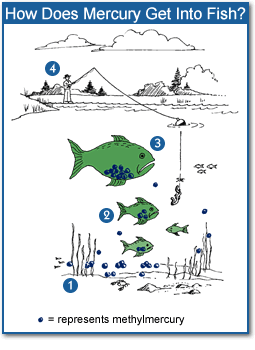 |
| Bioaccumulation |
The bioaccumulation is one of the factors used to determine the environmental impact of a substance. A substance with higher tendency towards bioaccumulation cause a greater hazard. Moreover, when a substance bioaccumulates at each step of the food chain, it multiplies. One can understand this phenomenon through the fish model.
The Fish Model
1. The substance enters the water body.
2. The substance sinks to the bottom of the water body.
3. Small creatures known as macroinvertebrates eat these toxic substances as they dig in the sendiment for food.
4. The macroinvertebrates are then eaten by minnows; minnows are in turn eaten by small or medium fish, and then they are eaten by large fishes, at each stage magnifying the bioaccumulated substance.
5. Similarly when these fishes are eaten by humans, they end up in our bodies.
Common Bioaccumulating Pollutants and Their Areas in Human
| Pollutant | Target Area |
|---|---|
| Lead | bone, teeth, nervous system |
| Mercury | nervous system |
| Organochlorine pesticides | fatty tissue, breast milk |
| Asbetos | lungs |
| Microplastics | lymphatic system, liver |
However, some organism show bioaccumulation as the defence mechanism by consuming toxic plants and animals. One such example is Tabacco Hornworm who bioaccumlates the nicotine to the toxic levels by consuming tabacco.
Image Source: MERC Vermont
